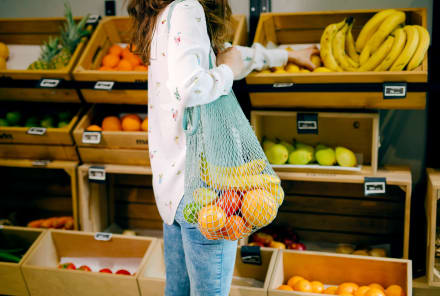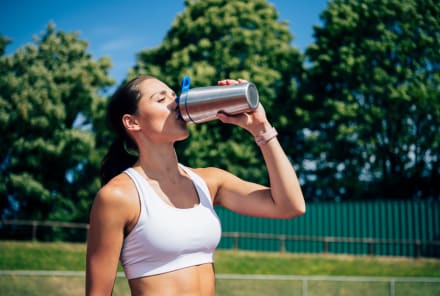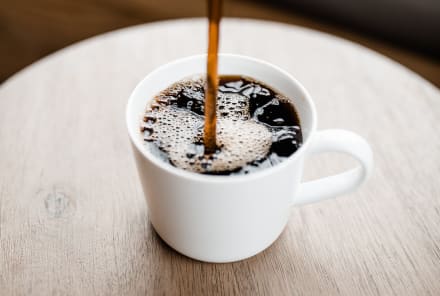Advertisement
Oily Skin During Your Luteal Phase? Here's Why + What To Do About It


Your monthly menstrual cycle is an intrinsic and unavoidable part of the body's natural system, and you've probably noticed that each week of your cycle feels a little different. There's a biological reason for that, and it's the same reason your skin might seem oilier versus drier at different parts of the month.
Here's what to do about it, according to women's health experts.
The truth about greasy foods during the luteal phase
As a refresher, the luteal phase is the time of your menstrual cycle that begins after ovulation and lasts until you start your period. During this phase, progesterone levels are peaking as your uterus prepares for the implantation of an embryo and pregnancy—and this is also the time when many women experience PMS symptoms.
As triple-board-certified OB/GYN Anna Cabeca, D.O., previously wrote for mindbodygreen, some women will feel PMS symptoms during the luteal phase, especially if there are lower than optimal progesterone levels. "Some may even experience symptoms of premenstrual dysphoric disorder (PMDD), so we're talking anxiety and depression, bloating, water retention, some brain fog, memory loss, mood swings, sleep disturbance, and a decrease in libido," she says.
And if that wasn't enough, it's not uncommon for skin to feel more oily during this phase, too. As registered dietitian-nutritionist and fertility expert Lauren Manaker, M.S., RDN, tells mindbodygreen, "During this phase, it is true that sebum production can ramp up, thanks to an increase in progesterone. This change can lead to people appearing more 'oily.'"
And according to her, while there are certain healthy "oily" foods that can actually help during your luteal phase, you'll want to avoid the processed stuff. "Deep fried foods, which tend to be oily, can be limited during this phase to support hormonal health," Manaker explains.
Cabeca echoes this point, previously writing that blood-sugar balance is especially important during this phase. "To keep your blood sugar balanced, you'll want to be careful taking in any additional glucose or carbohydrates until the last few days of your cycle—i.e., before your period starts," she says.
What to eat during your luteal phase
Since your body is preparing for pregnancy during the luteal phase, it naturally has higher glucose levels and more cravings, Cabeca explains, highlighting the importance of blood sugar balance. As such, she recommends eating healthy high-quality, free-range, and organic proteins, when possible, as well as healthy fats, like olive oil and avocado.
Manaker agrees, telling mindbodygreen that while they might be "oily," low-mercury fish (like sardines and salmon) provide important nutrients, like omega-3 fatty acids that may help with menstrual cramps, manage chronic inflammation, and help manage mood. "Oily fish is also a source of vitamin B6, which is an important nutrient to consume during the luteal phase," she adds.
Avoiding high-carbohydrate foods and simple sugars, since your blood glucose will already be higher, is key here, according to Cabeca, as is keeping cortisol under control, too.
And according to physician Bindiya Gandhi, M.D., you can also focus on "eliminating foods" that help flush estrogen out from the body, such as broccoli seed sprouts and other anti-inflammatory foods rich in antioxidants, "to fight off free radicals and continue to support your liver where estrogen is metabolized1."
The takeaway
As if PMS cramps weren't enough, the luteal phase of the menstrual cycle often brings with it mood swings, higher cortisol and blood sugar levels, and oily skin to top it all off. But with the right dietary choices, you can help keep your hormones more balanced, flush out that extra estrogen, and help tamp down oily skin, too.
Watch Next
Enjoy some of our favorite clips from classes
Enjoy some of our favorite clips from classes
What Is Meditation?
Mindfulness/Spirituality | Light Watkins
Box Breathing
Mindfulness/Spirituality | Gwen Dittmar
What Breathwork Can Address
Mindfulness/Spirituality | Gwen Dittmar
The 8 Limbs of Yoga - What is Asana?
Yoga | Caley Alyssa
Two Standing Postures to Open Up Tight Hips
Yoga | Caley Alyssa
How Plants Can Optimize Athletic Performance
Nutrition | Rich Roll
What to Eat Before a Workout
Nutrition | Rich Roll
How Ayurveda Helps Us Navigate Modern Life
Nutrition | Sahara Rose
Messages About Love & Relationships
Love & Relationships | Esther Perel
Love Languages
Love & Relationships | Esther Perel

















